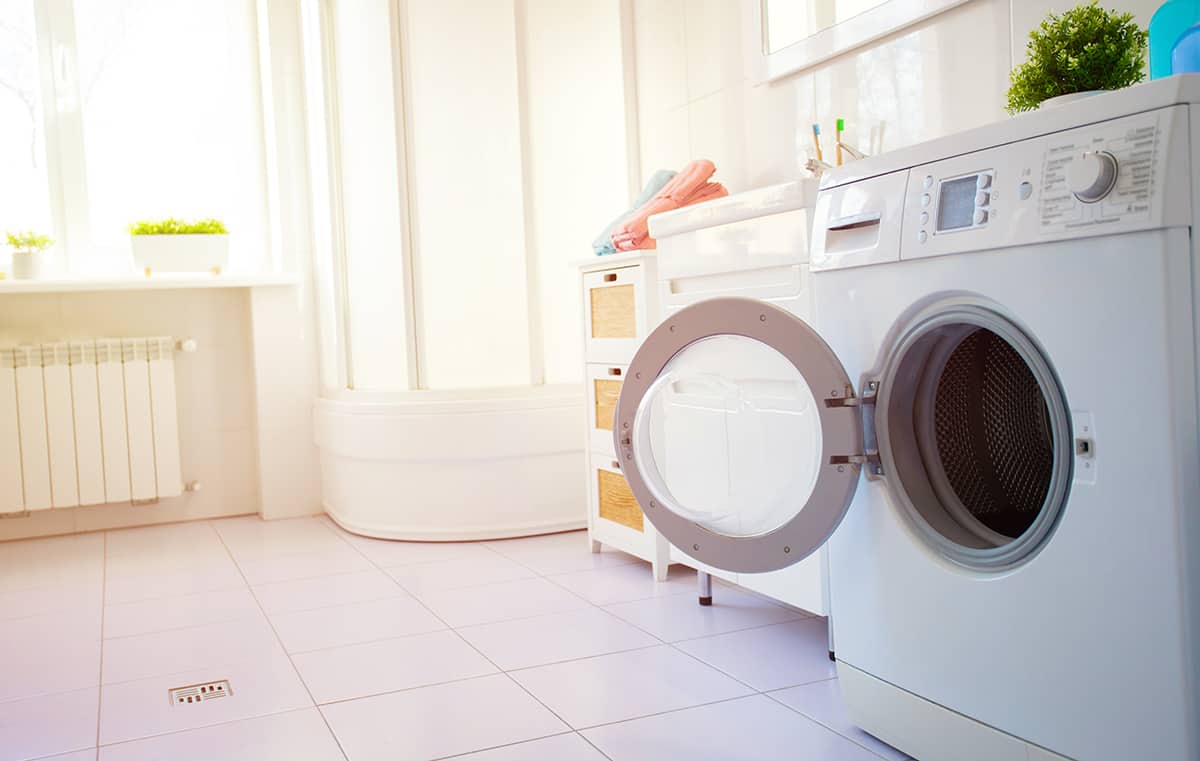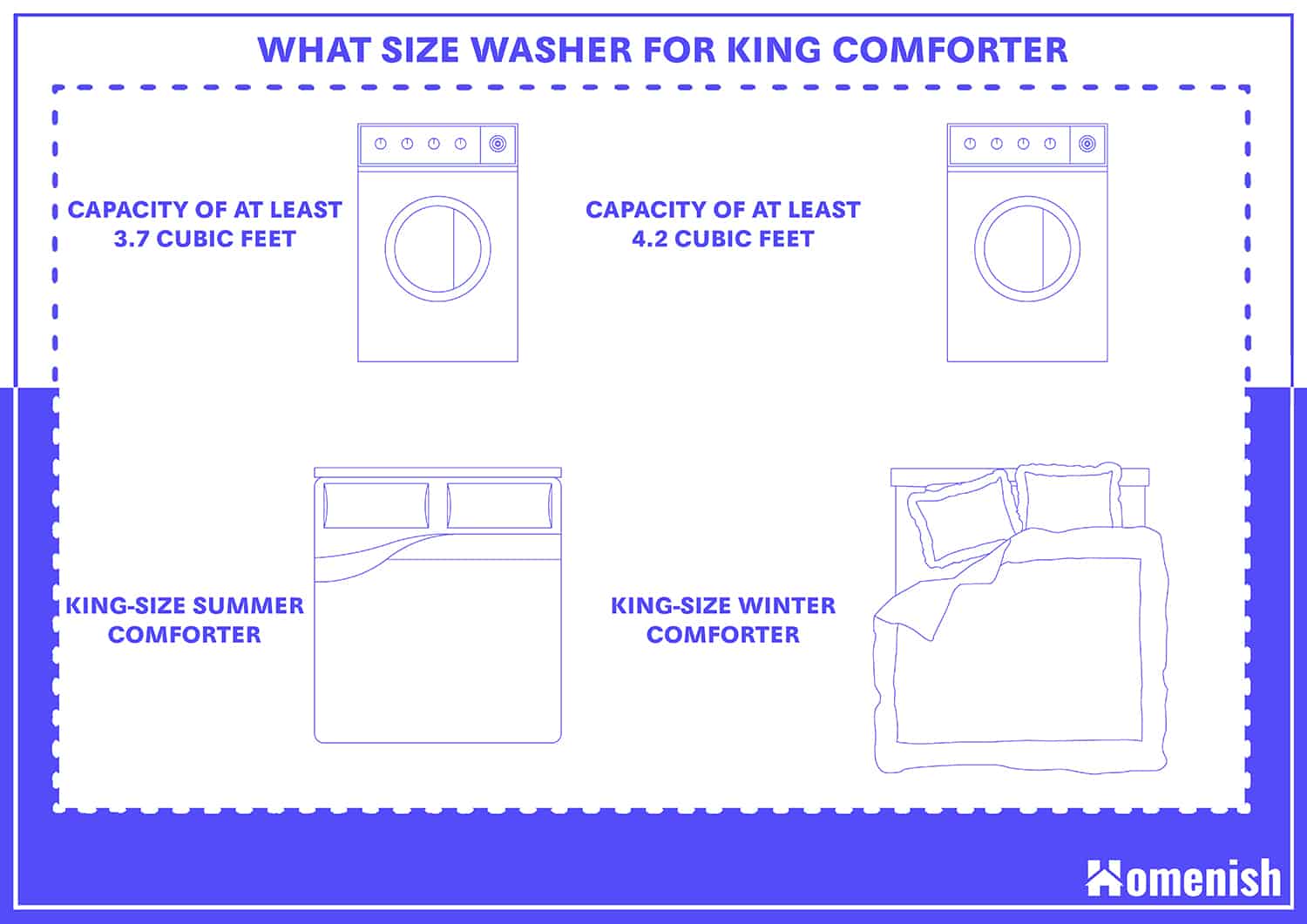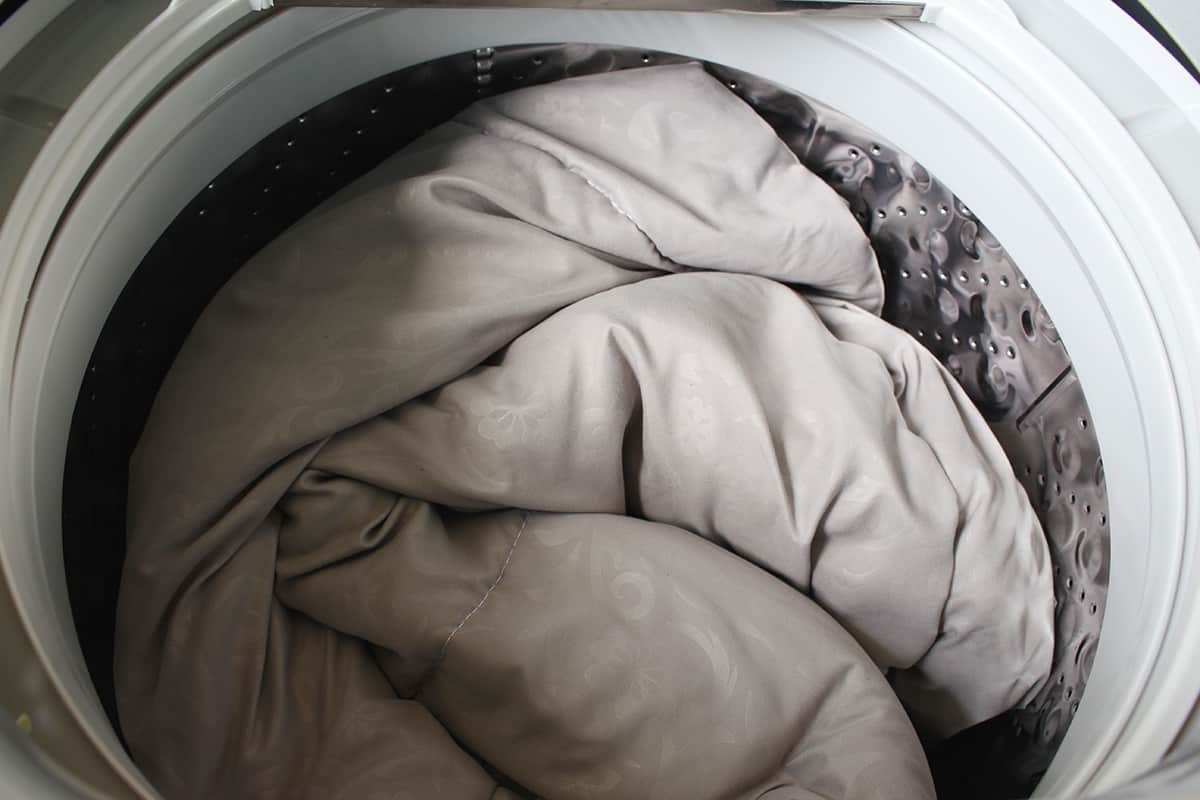King-size comforters are a popular choice, even on beds that are smaller than king-size, because they give a feeling of being snuggled in luxury.
However, king-size comforters can be problematic to clean because they are simply so enormous that they don’t easily fit into all types of washing machines.
Here we look at what size washer you would need to clean a king comforter at home and alternatives you could consider if your washing machine doesn’t have a big enough capacity.
Size Washer For King Comforter
The best type of washing machine to clean a king-size comforter is a front-loading washer. This is because they most typically have a bigger drum that accommodates a higher capacity of laundry, and they don’t feature an agitator in the center like top-loading machines, which can damage large bedding items like comforters.
For a king-size summer comforter that is a medium to lightweight tog, you will need a washing machine that has a capacity of at least 3.7 cubic feet. For a winter king comforter that has a higher tog, you will want to ensure your washing machine has a capacity of at least 4.2 cubic feet.
Tips For Machine Washing King Comforters
Read care label
The first thing you should do before attempting to machine wash your king comforter is read the care label. This will tell you if your comforter is suitable for washing at home. If it contains sensitive fabrics such as wool or silk, then these can suffer damage or shrinkage in a washing machine and will need to be sent to the dry cleaners.
The care label on your comforter may also specify a temperature setting that you should wash it at; pay attention to this if you don’t want to cause irreversible damage to your bedding.
If you have a down-filled comforter, you can, in fact, wash this in your washing machine at home. It is a common misconception that these would need to be dry-cleaned, but if your care label doesn’t specifically say it needs to be dry-cleaned, then you are safe to wash the item yourself.
Wash individually
Always wash your king comforter by itself, and don’t be tempted to squeeze other laundry items into the washer.
To be washed properly, the comforter needs to have adequate space around it so that the detergent and water can properly penetrate all of the material. Adding additional items into your machine will result in a comforter that may need to be re-washed.
Treat stains
If your comforter has suffered any stains, pre-treat these with an anti-stain formula following the manufacturer’s instructions before adding the bedding to the washing machine. This will mean that you won’t need to use a harsh detergent for the rest of the comforter.
Use gentle detergent
To extend the life of your king comforter, wash it with a mild detergent. These are more gentle on fabrics and will help the colors on your comforter to remain vibrant and for the material to stay softer for longer.
Select correct setting
The care label on your comforter may recommend the temperature setting your comforter should be washed at. If it doesn’t, choosing a gentle cycle with an extra rinse will be the most appropriate choice for general washing of your comforter.
Cool or warm water is better for protecting fabrics and colors. However, if you are concerned about dust mites, then wash the comforter on a hot setting to destroy them.
Use fabric conditioner
Using a fabric conditioner will help to keep your comforter soft and give it a lasting, pleasant scent. This is a particularly important step if you do not plan to dry your comforter in a tumble dryer. Without fabric conditioners, line-dried laundry can develop a tough or stiff texture.
How to Dry a King Comforter
After you have washed your king comforter, you will need to dry it before storing it away or putting it back onto the bed. If the weather is appropriate, hanging your comforter outside to line dry is a good option. Pale-colored comforters especially will benefit from this because the sun will bleach any stains and revive bright white fabrics.
If you have a dryer of a suitable capacity available, it’s a good idea to throw the comforter in after it has been dried outside. The dryer will fluff up the comforter and give it a more plush feel.
In the event of cold or wet weather, move your king comforter right from the washer to the dryer. Adding tennis balls to the dryer will help to ensure the comforter dries more evenly, and they will help to ensure the even spread of the filling inside the comforter.
If you don’t use tennis balls, you will want to pause the dryer every 30 minutes and shake the comforter out to disperse the filling before putting it back into the dryer. The benefit of drying your king comforter in a dryer is that it will dry out quickly and will come out feeling soft and plump.
You can also add dryer sheets to add scent and reduce static energy instead of using fabric conditioners in the washing stage. Dryers use hot air, which will also destroy any dust mites, so if you plan to take this step, then you can wash the comforter on a cool or warm wash instead of at a higher temperature. The drawback of drying king comforters is, of course, that they use energy which can be costly and have a negative environmental impact.
Alternatives to Washing King Comforter in Washer
If you don’t have a washing machine with a large capacity drum, then don’t be tempted to squeeze your king comforter in. This will not properly clean your comforter and can even damage your washing machine. Instead, take your king comforter to a laundromat where you can use an industrial-sized machine to wash it.
Alternatively, you can take it to be dry cleaned, which is a more expensive but easier job. If this option doesn’t appeal to you, you can hand wash your comforter at home if you have a large or deep bathtub.
To do this, half fill the tub with warm water and add in a gentle detergent, swirling it around until it is evenly dispersed. Slowly lower your king comforter into the tub until it is completely submerged, and use your hands to gently move it around in the water. Leave the comforter in the tub for a few hours to soak, or ideally overnight.
Remove the plug and allow the water to go down the drain, leaving your wet comforter in the tub. Now refill the tub with warm water to rinse the detergent out of the fabric. After another hour, gently squeeze the comforter to encourage water to drip out of it, and repeat this step until most of the water is removed.
Transfer the damp comforter to a plastic laundry basket and use this to transport it to the dryer or outside, as it will prevent any drips from being trailed through your home. Now you can dry the comforter as you wish.








